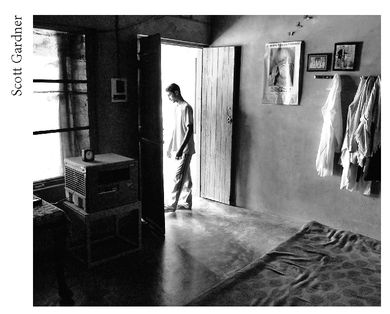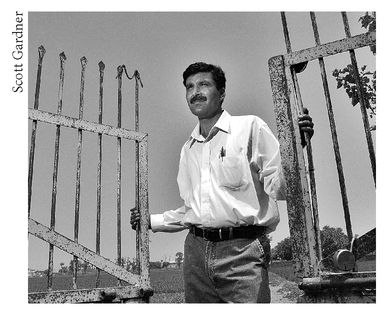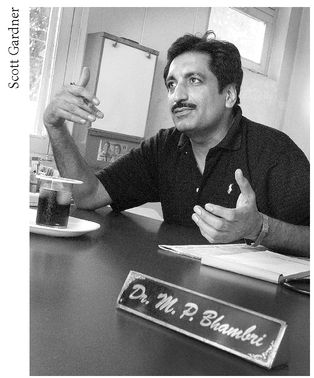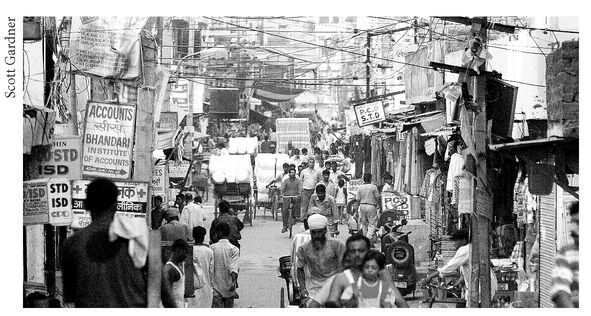Poison (28 page)
Authors: Jon Wells

Sarabjit’s brother, in the family home in Panj Grain

The symptoms sounded like strychnine poisoning. Korol and Dhinsa assumed the babies were cremated, which meant there was no forensic evidence to be found. Sarabjit told the detectives how Dhillon had insisted she not name the newborns. He had said it would bring bad luck. Sarabjit said Dhillon had visited his sons just once, here at her home, and had been alone with them for several minutes. She talked hesitantly about her life with Dhillon.
“My parents kept telling him that he should take me to Canada,” she said quietly. “He just kept saying, ‘I’m getting the papers ready.’ ”
She stared at the floor as she spoke, averting her eyes from the men.
“Jodha told people that I had been married before, and that I was really 40 years old, and that I had children before. My grandfather yelled at him, swore at him. ‘Take me to the one who said this,’ he said.”
They were nearly finished the interview. Then Gurjant said to Dhinsa, “Would you like to see where they were buried?”
Buried? They were buried in the village cemetery. Dhinsa, a Sikh who had attended a Catholic school in India, didn’t know that infants were not cremated. Gurjant led the detectives from the courtyard, turned left up the dirt road, then right. They passed through a large green metal gate and along a narrow 100-meter path through a corn field toward a five-foot-high brick wall enclosing a rectangular area. Korol, Dhinsa, Kundu, and Sarabjit’s family marched up the path, the same one they had walked to bury the boys. Inside the brick wall lay a funeral pyre block. The rest of the cemetery was dirt baked hard as concrete, weeds and sharp-edged shrubs and plants growing wild.
Inspector Subhash Kundu at the gates of the cemetery

“This is the cemetery?” Korol said to Kundu. “There are no grave markers.”
“No.”
Korol’s mind leaped ahead. Forensic evidence. We have to find these bodies and dig them up. “Kevin, ask Gurjant to locate the graves. Don’t let Sarabjit’s brother see what he does.” Gurjant walked to the far end of the cemetery and pointed to the ground. He said the names Sarabjit had given the
boys in defiance of Dhillon. That’s Gurmeet. That’s Gurwinder. Then it was the brother’s turn to independently locate the graves. He got the names reversed but pointed to the exact same two spots in the hard earth. Korol was now thinking way beyond the legal jurisdiction of this trip.
boys in defiance of Dhillon. That’s Gurmeet. That’s Gurwinder. Then it was the brother’s turn to independently locate the graves. He got the names reversed but pointed to the exact same two spots in the hard earth. Korol was now thinking way beyond the legal jurisdiction of this trip.
“Kevin, we have to exhume these kids.”
Dhinsa looked at the unmarked graves, saying nothing. He agreed with his partner. But his mind instantly started calculating possibilities. Budgets for the police, the Crown’s office. The decision wasn’t up to Korol and Dhinsa. They would have to go through channels, take nothing for granted.
“I’m telling you right now, buddy,” Korol continued, “you’ll be making the return trip to dig them up.”
The detectives were so focused they didn’t notice the crowd gathering. At least 50 children had followed them to the cemetery. Some were standing on the brick wall. The Canadians were on display, especially the big white one. Foreigners like Korol visited places like New Delhi, or Chandigarh or the Taj Mahal in Agra. But they did not visit rural villages like Panj Grain. Many of the children had never seen a white person before. Children surrounded him. He had never experienced anything like it. He looked down into the faces of the kids with chocolate skin and bright eyes. They looked up at him with a mixture of curiosity, bewilderment, and challenge.
Fair skin is revered in India. Television ads push “fairness” cream for the less than 10 per cent of the population who can afford a TV set and who brood over such things as the hue of their skin. To see this six-foot-plus white-skinned giant stride among them was the biggest thing to happen in the village in a long time. They all watched as the investigators got back into their air-conditioned car. In a cloud of dust, the strangers were gone.
The next day, Korol and Dhinsa visited the M/S Duggal homeopathic store. Korol browsed the book collection. Prices were dirt cheap, like everything in India. With their budget, he joked, they could buy a fleet of Indian cars. He bought two books:
Modi’s Medical Jurisprudence and Toxicology
, a faded blue 900-page door-stopper with a taped spine, and a bible-sized 1,040-page book
called
Ruddock’s Homeopathic Vade Mecum
. He flipped to the index in
Ruddock’s
and looked under strychnine. On page 260 there was an illustration of the
kuchila
seeds that were the same kind that Subhash Kundu had purchased in the market days before.
Modi’s Medical Jurisprudence and Toxicology
, a faded blue 900-page door-stopper with a taped spine, and a bible-sized 1,040-page book
called
Ruddock’s Homeopathic Vade Mecum
. He flipped to the index in
Ruddock’s
and looked under strychnine. On page 260 there was an illustration of the
kuchila
seeds that were the same kind that Subhash Kundu had purchased in the market days before.
“Homicidal poisoning by strychnine is rare in India,” it said. “A case occurred in Seoni, in which a man suffered from the effects of poisoning as a result of taking betels (leaves and nuts chewed by many Indians) offered to him at a singing party by two persons with whom he was not on good terms.”
Poor terms indeed.
“There was a case in which a person in Moradabad District was given some wine mixed with strychnine, but he threw it out of his mouth suspecting it to be soap water. Some of the wine remained in the cup, and was drunk by his son, who died within half an hour.”
That night the detectives had dinner with Kundu in the Empress Room, the hotel’s in-house restaurant, then turned in for the night, the raw strychnine seeds in a bag in one suitcase.
In his hotel bed that night, Korol again cracked open
Modi’s
. He thought back to the cemetery in Panj Grain. Chapter V: Exhumation. “It becomes necessary to exhume bodies from graves when a suspicion of poisoning or some foul play such as criminal abortion, homicide or disputed cause of death arises. In India, such a procedure is not so common owing to the custom of cremating dead bodies.” The key point: exhumations do take place here. “In India and in England, no time limit is fixed for the disinterment of a body. In France, this period is limited to ten years and is 30 years in Germany.”
Modi’s
. He thought back to the cemetery in Panj Grain. Chapter V: Exhumation. “It becomes necessary to exhume bodies from graves when a suspicion of poisoning or some foul play such as criminal abortion, homicide or disputed cause of death arises. In India, such a procedure is not so common owing to the custom of cremating dead bodies.” The key point: exhumations do take place here. “In India and in England, no time limit is fixed for the disinterment of a body. In France, this period is limited to ten years and is 30 years in Germany.”
There was, of course, nothing said about foreigners coming to India to exhume a body—much less foreigners coming to India to exhume two newborns.
Modi’s
would need some updating by the time Korol and Dhinsa were through with the Dhillon case. Korol inserted a beige hotel pamphlet between the pages as a bookmark and turned out the light.
Modi’s
would need some updating by the time Korol and Dhinsa were through with the Dhillon case. Korol inserted a beige hotel pamphlet between the pages as a bookmark and turned out the light.
The next morning, they drove to Tibba and Bhambri Hospital, the place where Kushpreet’s family had taken her the day she collapsed. It was a run-down building painted peach in the
village of Sahnewal. Dr. Mohinder Bhambri, the hospital’s doctor and owner, shook the detectives’ hands and offered them water and Pepsi. He spoke English, wore a golf shirt, and had a black mustache. He smiled often as he spoke with the detectives. The drinking glasses sweating from the heat in the room, the doctor told Korol he had no record or memory of Kushpreet.
village of Sahnewal. Dr. Mohinder Bhambri, the hospital’s doctor and owner, shook the detectives’ hands and offered them water and Pepsi. He spoke English, wore a golf shirt, and had a black mustache. He smiled often as he spoke with the detectives. The drinking glasses sweating from the heat in the room, the doctor told Korol he had no record or memory of Kushpreet.
Dr. Mohinder Bhambri

“She arrived dead at the hospital,” Korol said.
“If that was the case, then there would not be any need for me to keep a record of her attendance,” he said.
“Are you aware of other cases of strychnine poisoning?” Korol asked.
“I’ve heard of them, yes,” Bhambri said. “Opium addicts. It usually happens to addicts when they mix strychnine with opium. Enhances the stimulative effect. Truck drivers use it to stay awake at night on the road.”
“Where do the addicts get the strychnine?”
“I don’t know, although there is probably a black market in Punjab where you could buy it.”
Korol read Bhambri the witness statements from Kushpreet’s family. They had brought her to the hospital, her body stiff. The doctor had told them she was dead, that they might as well go home.
“I’m sorry,” Bhambri said when Korol was finished. “I don’t recall that situation.”
Korol and Dhinsa went to the local police station in Sahnewal, ordered criminal record checks on members of Kushpreet’s family. None had ever been involved with police. They drove to Ludhiana, Dhillon’s home town. The blanket of smog over the city actually helped moderate the blazing heat of the sun, even while
choking the lungs. Visitors were greeted by the bronze statue of three revered figures in modern Indian history, their fists raised defiantly: father of modern India Mahatma Gandhi, independent India’s first prime minister, Jawaharlal Nehru, and Sikh hero Bhagat Singh. “Not much to see in Ludhiana.” That was the city’s description in a popular Indian travel guide. Foreign faces were an uncommon sight.
choking the lungs. Visitors were greeted by the bronze statue of three revered figures in modern Indian history, their fists raised defiantly: father of modern India Mahatma Gandhi, independent India’s first prime minister, Jawaharlal Nehru, and Sikh hero Bhagat Singh. “Not much to see in Ludhiana.” That was the city’s description in a popular Indian travel guide. Foreign faces were an uncommon sight.
Ludhiana overloaded the senses. It was raw, supercharged modern India without the British refinements of Chandigarh. Chandigarh’s orderly streets bustled; Ludhiana’s screamed. There was little to distinguish where one market ended and another began. The city was one endless line of fruit and vegetable stands, silk and sari shops with their chartreuse and fuchsia and emerald fabrics flapping in the hot breeze, appliance repairs, homeopathic and medicine shops, tailors, street vendors roasting ears of corn over open fires on the sidewalk. Down one street there was a shingle announcing the services of B.P. Singh, Advocate. Next to his, Narrinder Singh, Advocate. And another advocate. Then five, 10, 15, 20 more lawyers’ kiosks in a row.
Dhillon’s neighborhood in Ludhiana

They headed to an administration office, obtained marriage documents for Dhillon and Sarabjit. Then it was to the civil surgeon’s office for Kushpreet’s death certificate. They tried to find Birk Barsal, Dhillon’s old neighborhood. It is so buried in Ludhiana’s urban maw
that even people who lived within the city weren’t sure of how to get there. Kundu was able to locate it, however. At Dhillon’s family apartment, they interviewed Surinder Kaur Dhillon, his sister-in-law, the widow of Dhillon’s eldest brother, Darshan.
that even people who lived within the city weren’t sure of how to get there. Kundu was able to locate it, however. At Dhillon’s family apartment, they interviewed Surinder Kaur Dhillon, his sister-in-law, the widow of Dhillon’s eldest brother, Darshan.
Yes, she knew Dhillon was married to three women. She knew he had hit his eldest daughter when she objected to his marrying Sarabjit. Surinder had heard about the twins’ fate, and Kushpreet’s. She herself had gone to the funeral. Surinder told the detectives that Dhillon had cried after Kushpreet’s death.
“If he cried so much, why did he marry again in 10 days?” Kundu asked in Punjabi.
Other books
Untamed (Vampire Awakenings, Book 3) by Brenda K. Davies
At the Edge of the Sun by Anne Stuart
The Hanging Shed by Gordon Ferris
The Fenway Foul-Up by David A. Kelly
Love and Longing in Bombay by Chandra, Vikram
The Enterprise of England by Ann Swinfen
Out of Bounds (Reedsville Roosters #5) by Holley Trent
The Rose of York: Crown of Destiny by Worth, Sandra
The Hunted by Jacobson, Alan
Warrior's Song by Catherine Coulter
